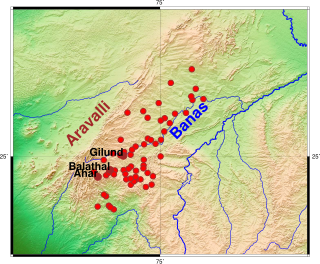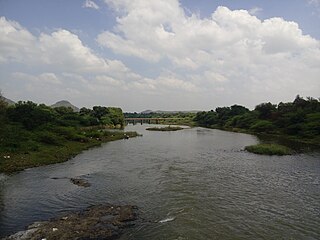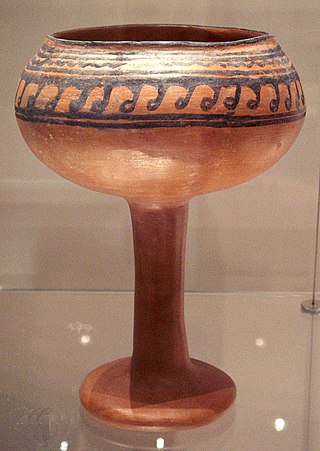
Rakhigarhi or Rakhi Garhi is a village and an archaeological site in the Hisar District of the northern Indian state of Haryana, situated about 150 km northwest of Delhi. It is located in the Ghaggar River plain, some 27 km from the seasonal Ghaggar river, and belonged to the Indus Valley civilisation, being part of the pre-Harappan, early Harappan, and the mature phase of the Indus Valley Civilisation.

Pottery in the Indian subcontinent has an ancient history and is one of the most tangible and iconic elements of Indian art. Evidence of pottery has been found in the early settlements of Lahuradewa and later the Indus Valley Civilisation. Today, it is a cultural art that is still practiced extensively in the subcontinent. Until recent times all Indian pottery has been earthenware, including terracotta.
Farmana Khas or Daksh Khera is an archaeological site in Meham block of Rohtak district in northern Indian state of Haryana spread over 18.5 hectares. It is located near the village of Farmana Khas, about 15 kilometers from the Rohtak-Hissar highway and 60 kilometres from Delhi. It is significant particularly for its burial site, with 70 burials, of the Mature Harappan period (2500–2000 BC) and fairly recent addition to Indus Valley civilisation sites excavated in India.

The Ahar culture, also known as the Banas culture is a Chalcolithic archaeological culture on the banks of the Ahar River of southeastern Rajasthan state in India, lasting from c. 3000 to 1500 BCE, contemporary and adjacent to the Indus Valley civilization. Situated along the Banas and Berach Rivers, as well as the Ahar River, the Ahar–Banas people were exploiting the copper ores of the Aravalli Range to make axes and other artefacts. They were sustained on a number of crops, including wheat and barley.
Gilund is a village and an archaeological site located in Rajsamand district of Rajasthan state in western India. It is one of five ancient sites excavated in the Ahar-Banas Complex which also includes the sites of Ahar, Ojiyana, Marmi, and Balathal. Out of the 111 reported sites found in the Ahar-Banas Complex, Gilund is the largest. The archaeological site was named after the present-day village, Gilund, and is locally known as Modiya Magari which means "bald habitation mound".

Balathal is an archaeological site located in Vallabhnagar tehsil of Udaipur district of Rajasthan state in western India. It is one of the ninety Ahar-Banas culture sites located in the Basins of the Banas river and its tributaries.
Daimabad is a deserted village and archaeological site on the left bank of the Pravara River, a tributary of the Godavari River in Shrirampur taluka in Ahmednagar district of Maharashtra state in India. This site was discovered by B. P. Bopardikar in 1958. It has been excavated three times so far by the Archaeological Survey of India teams. The first excavation in 1958-59 was carried out under the direction of M. N. Deshpande. The second excavation in 1974-75 was led by S. R. Rao. Finally, the excavations between 1975-76 and 1978-79 were carried out under the direction of S. A. Sali. Discoveries at Daimabad suggest that Late Harappan culture extended into the Deccan Plateau in India. Daimabad is famous for the recovery of many bronze goods, some of which were influenced by the Harappan culture.
Madhukar Keshav Dhavalikar was an Indian historian and archaeologist.
Jorwe is a village and an archaeological site located on the Pravara, a tributary of the Godavari River in Sangamner taluka of Ahmednagar district of Maharashtra state in India. This site was excavated in 1950-51 under the direction of Hasmukh Dhirajlal Sankalia and Shantaram Bhalchandra Deo.

Ghod River is located in Pune District, Maharashtra, western India. It is a tributary of the Bhima River. The Ghod originates on the eastern slopes of the Western Ghats at 1,090 metres (3,580 ft) above sea level. It flows in an east-southeast direction for approximately 200 kilometres (120 mi) before its confluence with the Bhima. It flows from the northern side of the Sahyadri Hills.

Hasmukh Dhirajlal Sankalia was an Indian Sanskrit scholar and archaeologist specialising in proto- and ancient Indian history. He is considered to have pioneered archaeological excavation techniques in India, with several significant discoveries from the prehistoric period to his credit. Sankalia received the Ranjitram Suvarna Chandrak award in 1966. And also received Padma Bhushan in the year 1974.

Nindowari, also known as Nindo Damb, is a Kulli archaeological site, dating back to chalcolithic period, in Kalat District of Balochistan, Pakistan. Archaeological investigation of the site suggests that the Nindowari complex was occupied by the Harappans before the Kulli civilization arrived and that the Kulli culture was related to or possibly derived from the Harappan culture.
Binjor - 4MSR is an archaeological site in Rajasthan state of India, near the international border between Pakistan and India. It is situated a couple of kilometers from Binjor village, Anupgarh tehsil, Sri Ganganagar district.

Chandoli Budruk is a village in Ambegaon Taluka of Pune district in the Indian state of Maharashtra. According to 2011 Census the population of Chandoli Budruk is 3,546 out of which 1,777 are male and 1,769 are females. There are total 692 houses in Chandoli Budruk. The GP Code of Chandoli Budruk is 185274 and PIN Code is 410 503.
Kaytha or Kayatha is a village and an archaeological site in the Ujjain district of Madhya Pradesh, India, in the Tarana tehsil, near the city of Ujjain, on the banks of Choti-Kali Sindh river.

Archaeology in India is mainly done under the supervision of the Archaeological Survey of India.

The Malwa culture was a Chalcolithic archaeological culture which existed in the Malwa region of Central India and parts of Maharashtra in the Deccan Peninsula. It is mainly dated to c. 1600 – c. 1300 BCE, but calibrated radiocarbon dates have suggested that the beginning of this culture may be as early as c. 2000-1750 BCE.

The Jorwe culture was a Chalcolithic archaeological culture which existed in large areas of what is now Maharashtra state in Western India, and also reached north into the Malwa region of Madhya Pradesh. It is named after the type site of Jorwe. The early phase of the culture is dated to c. 1400-1000 BCE, while the late phase is dated to c. 1000-700 BCE.

Navdatoli is the name of a modern day village, but can also refer to a chalcolithic era settlement located on the Narmada River in Madhya Pradesh in central India. The ancient village was inhabited through four temporal stages, each defined by distinct types of pottery. The site was originally excavated between 1957 and 1959 over two seasons. Both the village and the site are located roughly a mile south of the modern day town of Maheshwar.

The Anarta tradition or Anarta ware is a chalcolithic culture tentatively dated between c. 3950 BCE to 1900 BCE based on radio carbon dates from Loteshwar and Gola Dhoro. The sites associated with it are located in Gujarat, India.










